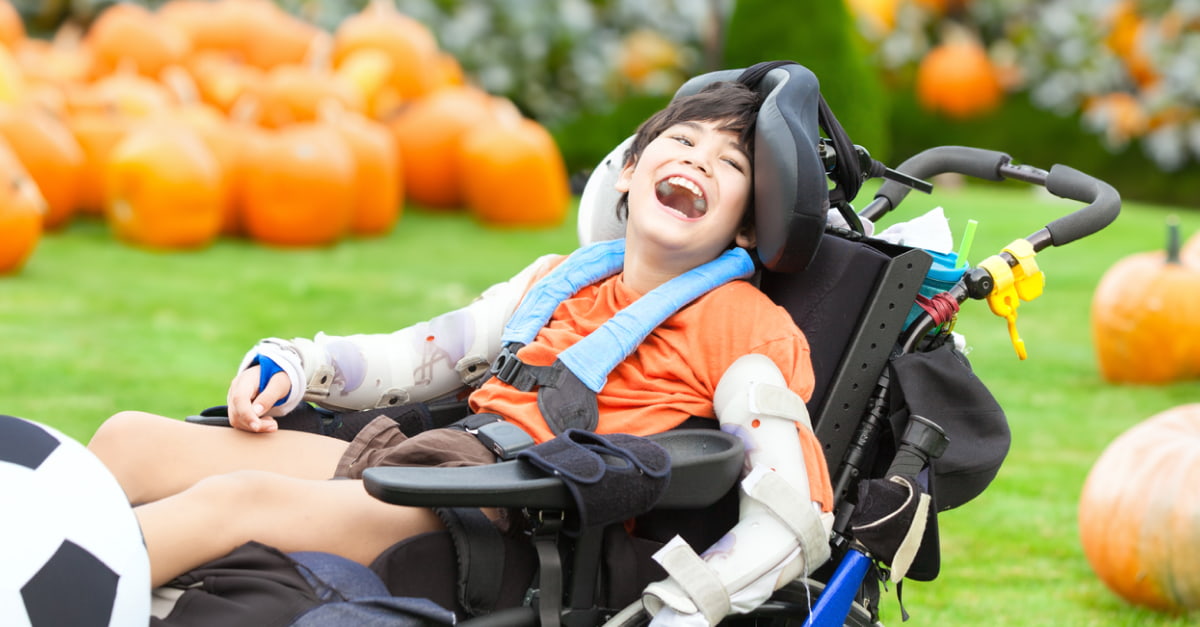5 Halloween Tips for Children With Cerebral Palsy

Children with cerebral palsy (CP) or other disabilities may sometimes feel left out of Halloween activities. However, you can help your child join the Halloween fun with some planning.
Whether they use a wheelchair or not, there are several ways to ensure your child has a happy and safe experience with friends, family, and their community.
Here are five tips to help create a memorable holiday for your child, while keeping their safety and needs top of mind.
1. Put Together a Wheelchair Costume
Wheelchair costumes make Halloween accessible for children with CP who rely on mobility aids and wheelchairs. One family looks forward to the holiday every year, as their son Anthony is eager to create elaborate Halloween wheelchair costumes.
This year, after a move from Illinois to Tennessee, Anthony is bringing some of Chicago to his new home as he dresses up as sports broadcasting legend Harry Bacay and turns his wheelchair into a broadcasting booth.
“Halloween is just a day when we can just stop looking at the actual wheelchair and look at the boy in the costume,” says his mother.
There are many clever and fun ideas for wheelchair costumes, including some trending ideas. For a guide to wheelchair costume ideas you can try with your child, consult this list of 30 wheelchair-friendly Halloween costume ideas.
2. Know Wheelchair Trick-or-Treating Safety
Unfortunately, not every neighborhood is easily accessible for wheelchair trick-or-treating. Sidewalks might be small, uneven, or blocked by cars or other obstacles.
To ensure your child's safety while trick-or-treating, consider the following tips:
- Plan your route by checking the neighborhood for any non-wheelchair-accessible areas
- Talk to your neighbors ahead of time to ask them to keep sidewalks and other areas accessible
- Add reflective lights onto the front and back of your child’s wheelchair
- Keep an eye out for cars that may come around the corner quickly
- Accompany your child to each house that you visit
3. Find Special Trick-or-Treating Events
Many towns and cities host special events, from trunk-or-treats to Halloween parties, festivals, and more. Some of these alternatives are more accessible than traditional trick-or-treating.
These events offer a fantastic alternative for kids with autism, CP, ADHD, and other health conditions that could make it difficult for them to enjoy Halloween due to sensory issues or physical limitations.
You can search for these events on local mobile apps, social media, your child’s school newsletters, and other local event sources.
4. Consider Alternatives to Trick or Treating
Even if your child can’t go trick-or-treating on Halloween, they can still have a wonderful time and celebrate in their own way.
If you’re up to it, you could plan a Halloween party at home with friends and family. This option allows children with CP to have fun in a way that makes them feel safe, supported, and included — no matter their age.
You can find several games to play and safe Halloween treats to make in order to create a fun Halloween party.
Here are a few fun and accessible party ideas:
- Decorating baked goods or other treats
- Finger painting pumpkins
- Hiring entertainment like a face painter, magician, or clown
- Singing and dancing along to Halloween music
It is important for children to feel involved and engaged. Play is an important part of learning for all children, no matter their abilities.
5. Prepare Your Child for Halloween Plans
For a child who may feel uncomfortable or uncertain in social situations, like kids with CP or autism, it’s important to prepare them ahead of time for how the event will go.
Here are some steps to take leading up to Halloween:
- Talk with your child before Halloween. Help them get excited for their costume, the festivities, and let them know the plan for the day/evening.
- Try on their costume to ensure it fits. Also, see if it is comfortable when moving around either in a wheelchair or with other mobility aids.
- Listen to your child’s concerns. While it’s important to encourage your child to participate in Halloween festivities, it is equally important for them to be listened to and supported if they express concerns.
- Keep an eye out for overwhelming environments. For example, strobe lights, which are used at many Halloween haunted house displays and for decoration, could be triggering if your child has epilepsy.
Find More CP and Disability Resources for Kids
Finding ways to keep holidays like Halloween accessible can be stressful emotionally and financially for families, especially when managing many other treatment appointments, tutoring, and more.
Cerebral Palsy Guide is committed to helping families support their children with cerebral palsy. Our team of advocates has helped families access financial support resources, treatment help, and more.
Contact us by calling (855) 220-1101 now to see how we can help you.
